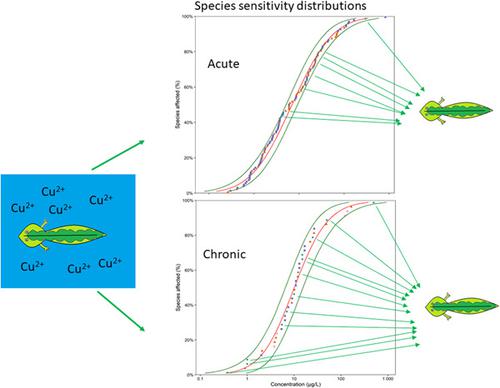当前位置:
X-MOL 学术
›
Environ. Toxicol. Chem.
›
论文详情
Our official English website, www.x-mol.net, welcomes your
feedback! (Note: you will need to create a separate account there.)
Sensitivity of Amphibians to Copper
Environmental Toxicology and Chemistry ( IF 3.6 ) Pub Date : 2021-03-22 , DOI: 10.1002/etc.5049 Ali Azizishirazi 1, 2 , Jaimie L Klemish 2 , Gregory G Pyle 2
Environmental Toxicology and Chemistry ( IF 3.6 ) Pub Date : 2021-03-22 , DOI: 10.1002/etc.5049 Ali Azizishirazi 1, 2 , Jaimie L Klemish 2 , Gregory G Pyle 2
Affiliation

|
Amphibian populations are declining globally. Major drivers of these global declines are known. However, the contribution of these major drivers to population declines varies by the presence or absence and the interactive effect of drivers, thus creating local challenges for conservation of populations. Studies have determined that environmental contaminants contribute to amphibian population declines. However, there is a disagreement over the use of amphibians as sentinel species in ecotoxicological testing rather than the traditional taxa used, fish and invertebrates. Reviews of ecotoxicological studies have demonstrated that amphibians are generally less sensitive than fish and invertebrates to different groups of contaminants. Nonetheless, because of the distinct nature and mechanism of toxicity of various contaminants, it is necessary to study contaminants individually to be able to come to any conclusion on the relative sensitivity of amphibians. Copper is one of the most studied environmental contaminants. We conducted a literature review of Cu toxicity to amphibians and the relative sensitivity of amphibians to other aquatic animals. The available data suggest that although amphibians may be tolerant of acute Cu exposure, they are relatively sensitive to chronic exposure (i.e., 100-fold greater sensitivity to chronic compared to acute exposure). In addition, ecologically relevant endpoints specific to amphibians (e.g., duration of metamorphosis and behavior) are shown to provide a better understanding of their sensitivity compared to traditional endpoints (e.g., survival and growth). Our current knowledge on amphibian sensitivity is far from complete. Considering the current status of this globally threatened class of animals, it is necessary to fill the knowledge gaps regarding their sensitivity to individual contaminants, beginning with Cu. Environ Toxicol Chem 2021;40:1810–1821. © 2021 SETAC
中文翻译:

两栖动物对铜的敏感性
全球两栖动物数量正在下降。这些全球下降的主要驱动因素是众所周知的。然而,这些主要驱动因素对人口下降的贡献因驱动因素的存在与否以及相互作用的影响而异,从而为当地的人口保护带来了挑战。研究已经确定,环境污染物会导致两栖动物数量下降。然而,在生态毒理学测试中使用两栖动物作为哨兵物种而不是使用的传统分类群、鱼类和无脊椎动物方面存在分歧。对生态毒理学研究的回顾表明,两栖动物通常不如鱼类和无脊椎动物对不同类别的污染物敏感。尽管如此,由于各种污染物的不同性质和毒性机制,有必要单独研究污染物,以便能够就两栖动物的相对敏感性得出任何结论。铜是研究最多的环境污染物之一。我们对铜对两栖动物的毒性和两栖动物对其他水生动物的相对敏感性进行了文献综述。现有数据表明,尽管两栖动物可能耐受急性铜暴露,但它们对慢性暴露相对敏感(即,与急性暴露相比,对慢性暴露的敏感性高 100 倍)。此外,与传统的终点(例如,生存和生长)相比,两栖动物特有的生态相关终点(例如,变态和行为的持续时间)被证明可以更好地理解它们的敏感性。我们目前关于两栖动物敏感性的知识还远未完成。环境毒物化学2021;40:1810–1821。© 2021 SETAC
更新日期:2021-03-22
中文翻译:

两栖动物对铜的敏感性
全球两栖动物数量正在下降。这些全球下降的主要驱动因素是众所周知的。然而,这些主要驱动因素对人口下降的贡献因驱动因素的存在与否以及相互作用的影响而异,从而为当地的人口保护带来了挑战。研究已经确定,环境污染物会导致两栖动物数量下降。然而,在生态毒理学测试中使用两栖动物作为哨兵物种而不是使用的传统分类群、鱼类和无脊椎动物方面存在分歧。对生态毒理学研究的回顾表明,两栖动物通常不如鱼类和无脊椎动物对不同类别的污染物敏感。尽管如此,由于各种污染物的不同性质和毒性机制,有必要单独研究污染物,以便能够就两栖动物的相对敏感性得出任何结论。铜是研究最多的环境污染物之一。我们对铜对两栖动物的毒性和两栖动物对其他水生动物的相对敏感性进行了文献综述。现有数据表明,尽管两栖动物可能耐受急性铜暴露,但它们对慢性暴露相对敏感(即,与急性暴露相比,对慢性暴露的敏感性高 100 倍)。此外,与传统的终点(例如,生存和生长)相比,两栖动物特有的生态相关终点(例如,变态和行为的持续时间)被证明可以更好地理解它们的敏感性。我们目前关于两栖动物敏感性的知识还远未完成。环境毒物化学2021;40:1810–1821。© 2021 SETAC











































 京公网安备 11010802027423号
京公网安备 11010802027423号